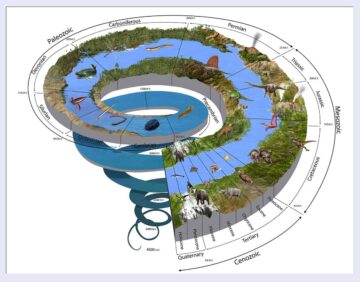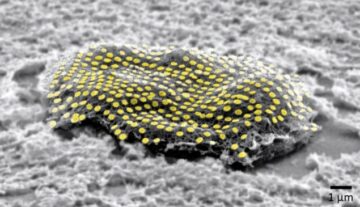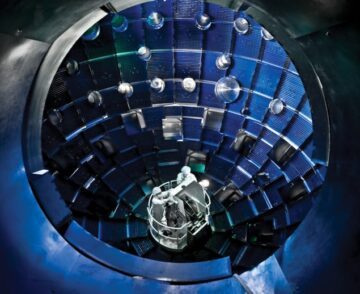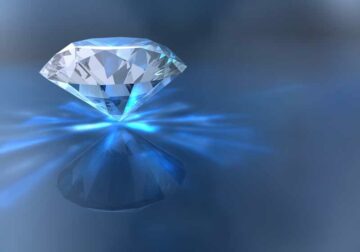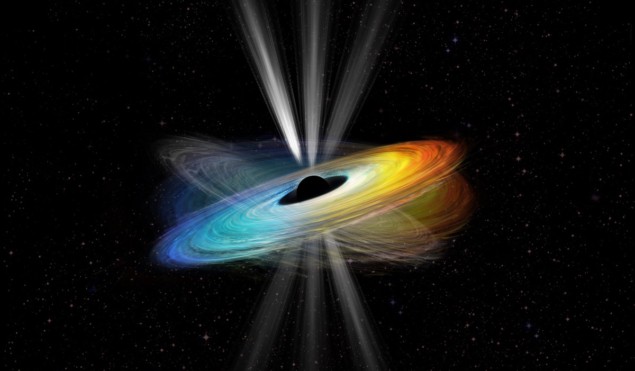
The relativistic jet emanating from the black hole at the heart of the galaxy Messier 87 (M87) is wobbling as it is dragged around by the spinning black hole, new radio observations have found. This is the first direct evidence that powerful jets from active galaxies are driven by black holes that are rotating rapidly, not slowly.
M87 is the giant elliptical galaxy found in the heart of the Virgo galaxy cluster, 55 million light-years away. It’s famous for being home to the first supermassive black hole to have its “shadow” imaged by the Event Horizon Telescope, back in 2019. M87 also produces a powerful jet of charged particles extending at least 5000 light-years from the black hole. This jet is so large and bright that it is even visible in images taken by amateur astronomers with garden equipment.
Although M87 was the first galaxy found to harbour a relativistic jet over a century ago, thousands of galaxies and quasars are now known to have jets. The material in such jets is dredged up by magnetic fields from an accretion disc of material spiralling around the black hole. Theory posited that the energy for the jet is extracted from the rotational energy of the black hole.
Now, an international team of astronomers – led by Yuzhu Cui of Zhejiang Laboratory in Hangzhou, China, and Kazuhiro Hada of Japan’s Graduate University for Advanced Studies and the National Astronomical Observatory of Japan – has made the first observations that directly support this theory, publishing the results in Nature.
“One of the most important implications from this study is that a spinning black hole is essential to generate a powerful relativistic jet as seen in M87 and other radio galaxies or quasars,” Hada tells Physics World.
“If the result is confirmed, it would really be a giant leap in our understanding of jets,” adds Yannis Liodakis of the University of Turku in Finland, who was not involved in the study. In 2022 Liodakis was the lead author of a paper in Nature that found shock fronts and turbulence in M87’s jet.
Spinning top
Combining 17 years’ worth of radio-astronomy observations from the East Asian VLBI Network (EAVN), the Very Long Baseline Array (VLBA), the joint array of KVN and VERA (KaVA) and the East Asia to Italy Nearly Global (EATING) VLBI network, amounting to more than 20 radio telescopes in total, Hada and the team discovered that M87’s jet is precessing.
Think of a spinning top, and how its axis of rotation seems to wander around in a circle. The jet in M87 is perpendicular to the accretion disc, but both jet and disc are misaligned with respect to the black hole’s rotational axis. As the black hole spins, it drags space-time around with it – an effect known as “frame-dragging”. As it does so, it pulls the accretion disc around, causing the direction that the off-axis jet points to precess, or wobble, by approximately 10 degrees with a period of about 11 years.
In 1973, the physicist John Wheeler famously posited his no-hair theorem – that a black hole can be fully characterized by just three parameters: its mass, its electric charge and its angular momentum (the “hair” is a metaphor for everything else – all other information enters the black hole and becomes inaccessible). The mass of M87’s supermassive black hole is about 6.5 billion times the mass of our Sun, and its electrical charge is considered to be negligible. However, despite this measurement of the precession of the jet as it is dragged around by the spinning black hole, it’s not yet possible to define a rate for that spin.
Black hole spin rate
However, one might surmise that black holes with powerful jets will have fast spins, while black holes with no jets will tend to be spinning more slowly.
“The jet precession period depends on both the black hole spin and the size of the accretion disc,” says Hada. Unfortunately, the size of M87’s disc is not well known. In their theoretical modelling, the team assumed 40 rotations per year, but that is just one possible solution – different spin values with different disc sizes could also explain the degree of precession.

New black hole image reveals magnetic fields
“Nevertheless, it is very likely that the black hole’s rotation time scale is much shorter than that of the jet and disc precession,” says Hada. “Measuring the value of this spin is exactly our next step to go. Hopefully this will be possible by combining our jet monitoring and a black hole movie from the Event Horizon Telescope.”
Liodakis points out how vital it is to know that fast-spinning black holes drive jets, because it will assist astronomers in constraining the size of the accretion disc at the centre of a galaxy such as M87, and the composition of such jets.
“It’s not an unexpected result,” says Liodakis. “But it is certainly great to have direct confirmation.”
- SEO Powered Content & PR Distribution. Get Amplified Today.
- PlatoData.Network Vertical Generative Ai. Empower Yourself. Access Here.
- PlatoAiStream. Web3 Intelligence. Knowledge Amplified. Access Here.
- PlatoESG. Carbon, CleanTech, Energy, Environment, Solar, Waste Management. Access Here.
- PlatoHealth. Biotech and Clinical Trials Intelligence. Access Here.
- Source: https://physicsworld.com/a/m87s-precessing-jet-reveals-black-holes-fast-spin/
- :has
- :is
- :not
- $UP
- 10
- 11
- 17
- 1973
- 20
- 2019
- 2022
- 2023
- 40
- 5000
- 87
- 90
- a
- About
- active
- Adds
- advanced
- ago
- AL
- All
- also
- amateur
- an
- and
- Angular
- approximately
- ARE
- around
- Array
- AS
- asia
- asian
- assist
- assumed
- At
- author
- away
- Axis
- back
- Baseline
- BE
- because
- becomes
- being
- Billion
- Black
- Black Hole
- black holes
- both
- Bright
- but
- by
- CAN
- causing
- centre
- Century
- certainly
- characterized
- charge
- charged
- China
- Circle
- Cluster
- combining
- composition
- confirmation
- CONFIRMED
- considered
- could
- define
- Degree
- depends
- Despite
- different
- direct
- direction
- directly
- discovered
- does
- drive
- driven
- effect
- Electric
- else
- energy
- Enters
- equipment
- essential
- Even
- Event
- Event Horizon Telescope
- everything
- evidence
- exactly
- Explain
- extending
- famous
- famously
- FAST
- Fields
- Finland
- First
- For
- found
- from
- fronts
- fully
- Galaxies
- Galaxy
- Garden
- generate
- giant
- Global
- Go
- graduate
- great
- Hangzhou
- Have
- Heart
- his
- Hole
- Holes
- Home
- Hopefully
- horizon
- How
- However
- HTML
- HTTPS
- image
- images
- implications
- important
- in
- inaccessible
- information
- International
- involved
- issue
- IT
- Italy
- ITS
- Japan
- Japan’s
- Jets
- John
- joint
- jpg
- just
- just one
- Know
- known
- lab
- laboratory
- large
- lead
- Leap
- least
- Led
- likely
- Long
- made
- Mass
- material
- max-width
- measurement
- might
- million
- modelling
- Momentum
- monitoring
- more
- most
- movie
- much
- National
- Nature
- nearly
- New
- next
- no
- now
- observations
- observatory
- of
- on
- ONE
- or
- Other
- our
- out
- over
- parameters
- per
- period
- PHP
- Physics
- Physics World
- plato
- Plato Data Intelligence
- PlatoData
- points
- possible
- powerful
- produces
- Publishing
- Pulls
- Radio
- rapidly
- Rate
- RE
- really
- respect
- result
- Results
- Reveals
- says
- Scale
- seems
- seen
- showing
- Size
- sizes
- Slowly
- So
- solution
- Spin
- spins
- Step
- studies
- Study
- such
- Sun
- support
- taken
- team
- telescope
- telescopes
- tells
- than
- that
- The
- the joint
- their
- theoretical
- theory
- this
- thousands
- three
- thumbnail
- time
- times
- to
- top
- Total
- true
- turbulence
- understanding
- Unexpected
- unfortunately
- university
- value
- Values
- very
- visible
- vital
- was
- WELL
- wheeler
- while
- WHO
- will
- with
- world
- worth
- would
- year
- years
- yet
- zephyrnet

